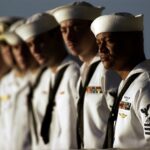Historic Naval Battles: From Pearl Harbor to Normandy
Throughout history, naval powers have fundamentally shaped the direction of global events. Periods of war have borne witness to momentous sea battles that have forever changed the course of history. Amongst the countless engagements that have occurred over thousands of years, the naval battles of Pearl Harbor and Normandy stand as two of the most significant in modern history.
The Attack on Pearl Harbor
Background
On December 7, 1941, the Japanese launched a surprise attack on the U.S. Pacific Fleet stationed at Pearl Harbor, Hawaii. This unprovoked act of aggression propelled the United States into World War II.
The Battle and its Impact
Early on a Sunday morning, Japanese aircraft carriers launched a two-wave attack. The first wave targeted airfields and battleships, while the second focused on other vessels and facilities. The U.S. was caught off guard, and within two hours, five of the eight mighty American battleships lay damaged or sinking, and nearly half of the U.S. Pacific Fleet was destroyed or severely compromised. Over 2,400 Americans were killed, and nearly 1,200 were wounded.
Beyond its devastating immediate impact, the attack on Pearl Harbor had far-reaching consequences. It marked not only the U.S. entry into World War II but also the beginning of a global shift in power dynamics.
The Invasion of Normandy
Background
D-Day, as it is often referred to, took place on June 6, 1944. This operation, formally known as Operation Overlord, was the largest seaborne invasion in history. Allied forces aimed to liberate German-occupied France and turn the tide of World War II in the Allies’ favor.
The Invasion and its Impact
The operation involved more than 7,000 ships and landing craft carrying troops and vehicles across the English Channel. American, British, and Canadian forces disembarked along five beach sectors codenamed Juno, Sword, Gold, Omaha, and Utah. Despite intense German resistance, by nightfall, the allies had gained a tenuous foothold in Normandy.
In the following weeks and months, the Allies poured men and materials into their beachhead, pushing the Germans back through France and onto the defensive in what would ultimately culminate in their defeat the following year.
One of the key factors contributing to the success of the Normandy invasion was the extensive use of naval bombardment. Allied warships targeted German positions along the coast, disrupting their defenses and rendering them vulnerable to the incoming troops.
Legacy of the Battles
The battles of Pearl Harbor and Normandy were pivotal events in World War II that underlined the power and strategic importance of naval forces and reshaped global geopolitics.
Pearl Harbor marked the eruptive entry of the United States into the war, leading to a bolder, more direct combat approach against Axis forces and ultimately changing the dynamics of the war. It also saw the emergence of the United States as a dominant world power in the post-WWII era.
The battle of Normandy, on the other hand, signified a turning point in the European theatre of war. The successful amphibious landing at Normandy started a chain of events leading to the liberation of France, and finally the defeat of Nazi Germany.
These actions place these battles among the most epic and consequential naval engagements in history, demonstrating the immense strategic value and power of sea forces in determining the course of wars and the shape of the world. Their impact and the profound changes they engendered continue to resonate in contemporary international relations and naval warfare strategies.


